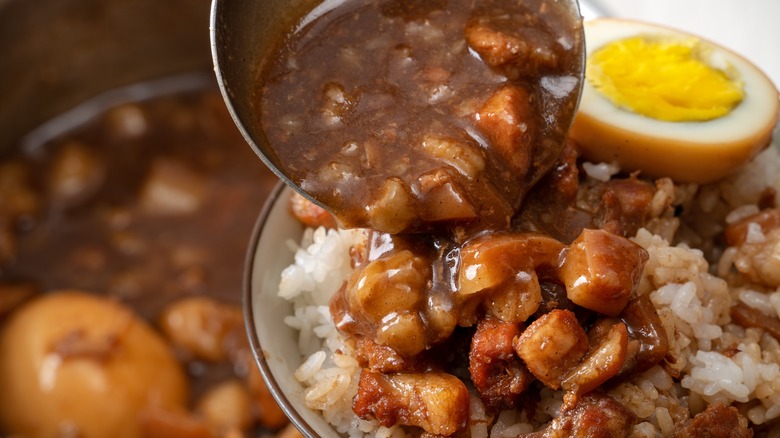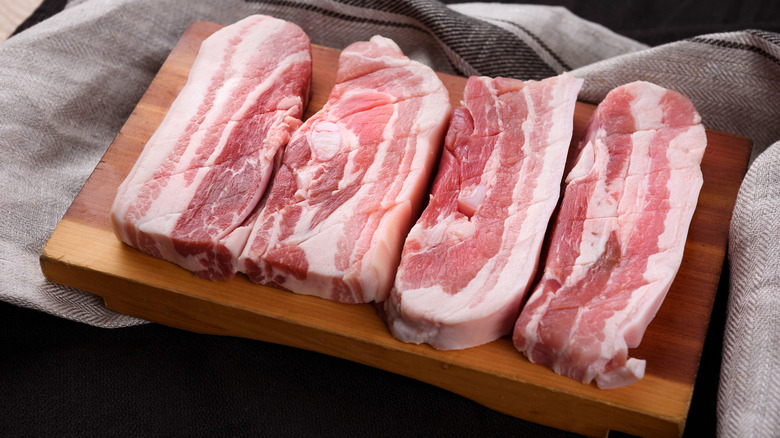What Makes Lu Rou Fan, A Taiwanese Meat Sauce, So Unique?
In Taiwan, you don't have to go far to find a warm bowl of lu rou fan. The braised pork dish, which translates to "stewed meat rice," is served up at countless restaurants, street vendors, and home kitchens across the East Asian country. Like beef noodle soup, hot pot, xiao long bao soup dumplings, and burrito-shaped fan tuan, the dish is an essential facet of Taiwanese comfort food.
Lu rou fan is so central to Taiwanese cuisine, in fact, that the Taipei government launched a campaign claiming ownership over it in 2011. Officials handed out bowl upon bowl of the dish to locals as a way of settling the age-old dispute over whether it originated in Taiwan or Shandong, China.
Of course, lu rou fan's intriguing history isn't the only thing that makes it unique; its ingredients are what set it apart from other braised meat dishes around the globe. While variations abound, the dish's standard form calls for minced pork braised in rice wine, soy sauce, water, sugar, and five-spice powder until tender and saucy. However, some Taiwanese chefs divert from that order. Lu rou fan is often served over rice or noodles.
Keep the skin on
No two bowls of lu rou fan are the same, but one universal rule to follow when making the dish at home is to keep the skin on if you're using pork belly. Doing so will lend a satisfying texture and fatty flavor to the final dish. However, northern versions of the dish tend to sway toward ground pork, so you can follow whichever regional variation suits your fancy.
Eric Sze, the chef and owner of buzzy New York City Taiwanese spots 886 and Wenwen, shared his self-described "super traditional" version with Munchies. He starts by blanching the pork belly to help keep its shape to rid it of any bacteria that might be lingering on the surface. While the pork simmers for 30 minutes, he makes dashi and tosses in some dried shitake mushrooms for extra depth.
After the pork is cool enough to handle, he cuts it into bite-sized cubes and makes a quick caramel from rock sugar, oil, and hot water. He sears the pork belly in that syrupy liquid to give it a golden hue before transferring it to a plate and dropping chopped scallions, shallots, and ginger into the same pot. Finally, he adds soy sauce, the dashi, and a whole lot of fried shallots, letting everything simmer on the stove for an hour or so. As a final touch, Sze garnishes his lu rou fan with pickled cucumbers.
Staking claim
Sze maintains that lu rou fan was invented in Taiwan when the country was under Japanese rule. Others still aren't sure whether the dish got its start in Taiwan or China. According to The Woks of Life, lu rou fan shares many similarities with hong shao rou, a pork belly dish from Shanghai that translates to "red cooked pork." Unlike lu rou fan, however, hong shao rou is made with larger cuts of pork belly and different spices.
We obviously know where the Taipei City Government stands. Its decision to give away 1,000 bowls of lu rou fan was a response to a Michelin Green Guide claim that the dish originated in China. "Today we're here to let everyone know that lu rou fan is genuine Taiwanese cuisine, a national delicacy, not a 'Shandong-style' dish," said Taipei Mayor Hau Lung-bin in a statement at the time.
One thing's for certain: lu rou fan is delicious, supremely comforting, and definitely worth making at home.


